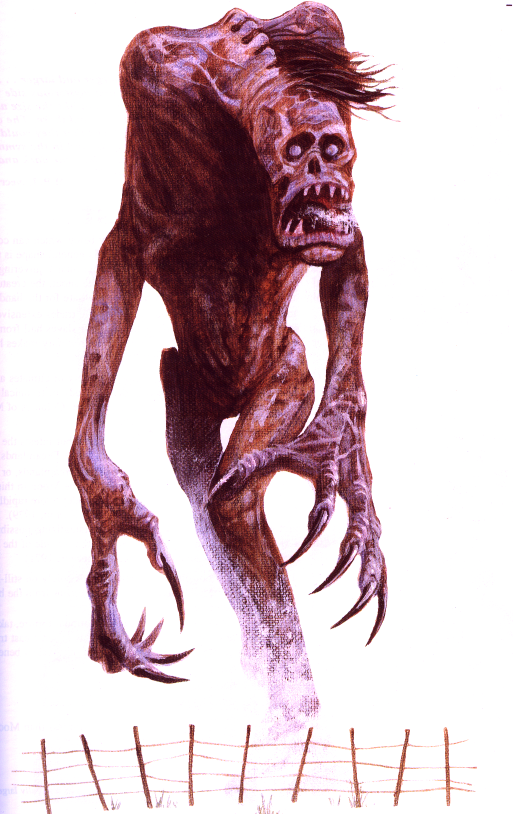
The Big Black Book
The Wendigo (also known as Windigo, Weendigo, Windago, Windiga, Witiko, Wihtikow, and numerous other variants) is a creature appearing in the mythology of the Algonquian people. It is a malevolent cannibalistic spirit into which humans could transform, or which could possess humans. Those who indulged in cannibalism were at particular risk, and the legend appears to have reinforced this practice as a taboo.
In Algonquian mythology[]
The Wendigo is part of the traditional belief systems of various Algonquian-speaking tribes in the northern United States and Canada, most notably the Ojibwa/Saulteaux, the Cree, and the Innu/Naskapi/Montagnais. Though descriptions varied somewhat, common to all these cultures was the conception of Wendigos as malevolent, cannibalistic, supernatural beings (manitous) of great spiritual power. They were strongly associated with the Winter, the North, and coldness, as well as with famine and starvation. Basil Johnston, an Ojibwa teacher and scholar from Ontario, gives one description of how Wendigos were viewed: The Wendigo was gaunt to the point of emaciation, its desiccated skin pulled tautly over its bones. With its bones pushing out against its skin, its complexion the ash gray of death, and its eyes pushed back deep into their sockets, the Wendigo looked like a gaunt skeleton recently disinterred from the grave. What lips it had were tattered and bloody [....] Unclean and suffering from suppurations of the flesh, the Wendigo gave off a strange and eerie odour of decay and decomposition, of death and corruption.
At the same time, Wendigos were embodiments of gluttony, greed, and excess; never satisfied after killing and consuming one person, they were constantly searching for new victims. In some traditions, humans who became overpowered by greed could turn into Wendigos; the Wendigo myth thus served as a method of encouraging cooperation and moderation.
Among the Ojibwa, Eastern Cree, Westmain Swampy Cree, and Innu/Naskapi/Montagnais, Wendigos were said to be giants, many times larger than human beings (a characteristic absent from the Wendigo myth in the other Algonquian cultures). Whenever a Wendigo ate another person, it would grow larger, in proportion to the meal it had just eaten, so that it could never be full. Wendigos were therefore simultaneously constantly gorging themselves and emaciated from starvation.
Human Wendigos[]
All cultures in which the Wendigo myth appeared shared the belief that human beings could turn into Wendigos if they ever resorted to cannibalism or, alternately, become possessed by the demonic spirit of a Wendigo, often in a dream. Once transformed, a person would become violent and obsessed with eating human flesh. The most frequent cause of transformation into a Wendigo was if a person had resorted to cannibalism, consuming the body of another human in order to keep from starving to death during a time of extreme hardship or famine.
Among northern Algonquian cultures, cannibalism, even to save one's own life, was viewed as a serious taboo; the proper response to famine was suicide or resignation to death. On one level, the Wendigo myth thus worked as a deterrent and a warning against resorting to cannibalism; those who did would become Wendigo monsters themselves.
Wendigo ceremony[]
Among the Assiniboine, the Cree and the Ojibwa, a satirical ceremonial dance was originally performed during times of famine to reinforce the seriousness of the Wendigo taboo. The ceremonial dance, known as a wiindigookaanzhimowin in Ojibwe and today performed as part of the last day activities of the Sun dance, involves wearing a mask and dancing about the drum backwards. The last known Wendigo Ceremony conducted in the United States was at Lake Windigo of Star Island of Cass Lake, located within the Leech Lake Indian Reservation in northern Minnesota.
Recent Occurrences[]
In 2009 it is believed from all available evidence that The Shop attempted to capture a Wendigo in an effort to control and weaponize one. This utterly failed. From forensic evidence gathered from the remains of the camp they did not die easy deaths.
Bureau Policy[]
DO NOT seek out this creature, do not accost it if it is seen, do not approach. Don't even think too much about them. Get all civilians out of the area, by force if necessary. No matter your intentions a Wendigo encounter can only end badly.
It is noted that native populations will not give you trouble in this regard. Your biggest challenge will be "skeptics" and "intellectuals". If they insist on being a distraction, get the sensible people, and yourself, out of there.
